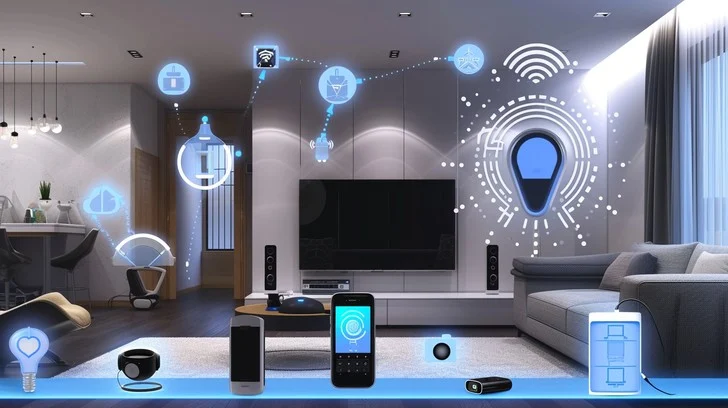
In today’s modern world, smart home technology is revolutionizing the way we interact with our living spaces. Home automation has advanced far beyond basic convenience, now offering seamless integration with interior design to enhance aesthetics, functionality, and efficiency. Whether through smart lighting solutions or connected home devices, homeowners can create a sophisticated environment that is both intelligent and stylish.
The Rise of Smart Home Integration
Smart home technology is no longer a futuristic concept—it is a reality transforming homes worldwide. As homeowners look for ways to blend aesthetics with technology, interior designers are incorporating smart features without compromising on style. From voice-activated controls to automated lighting that adapts to different moods, smart home integration is redefining modern living spaces.
Why Smart Home Integration Matters
- Enhanced Convenience – With home automation, controlling various aspects of a home, such as lighting, temperature, and security, is easier than ever.
- Energy Efficiency – Smart lighting solutions and connected thermostats help reduce energy consumption by adjusting usage based on real-time needs.
- Security & Safety – Connected home devices, including surveillance cameras and smart locks, provide enhanced security and peace of mind.
- Aesthetic Appeal – Modern smart technology blends seamlessly into home decor, maintaining a clean and stylish look.
Incorporating Smart Technology into Interior Design
When integrating smart home solutions, it’s essential to prioritize both functionality and design. Here’s how you can achieve a balance between technology and aesthetics:
1. Smart Lighting Solutions for Ambiance and Efficiency
Lighting plays a crucial role in home design, setting the mood and highlighting architectural features. Smart lighting solutions offer a combination of customization, efficiency, and elegance.
- Dimmable LED Lights: Smart LED bulbs can adjust brightness and color temperature to match different times of the day.
- Voice & App Control: Systems like Philips Hue or Lutron allow homeowners to control lights using voice commands or mobile apps.
- Automated Schedules: Pre-set lighting schedules create a welcoming ambiance while improving energy efficiency.
- Hidden Fixtures: Smart lighting can be installed in concealed locations, such as under cabinets or within ceiling recesses, enhancing the room’s aesthetics.
2. Seamless Smart Home Automation Systems
A well-integrated home automation system ensures that technology enhances daily life without overwhelming the home’s design.
- Centralized Control Hubs: Devices like Amazon Echo, Google Nest Hub, or Apple HomeKit provide an intuitive interface for managing connected home devices.
- Smart Thermostats: Solutions like Nest or Ecobee adjust temperature settings based on user preferences and external weather conditions.
- Motorized Blinds & Shades: These can be programmed to open and close at specific times, balancing natural light and privacy without manual intervention.
3. Connected Home Devices that Blend with Decor
Not all smart devices need to be obtrusive. Many brands focus on designing connected home devices that complement modern interiors.
- Smart Mirrors: Integrated with LED lighting and display features, these mirrors can show weather updates, news, or fitness stats.
- Discreet Smart Speakers: Devices like Sonos or Echo Studio deliver premium sound quality while blending into home decor.
- Invisible Charging Stations: Wireless charging pads built into furniture eliminate clutter and maintain a sleek appearance.
- Art Frame TVs: Televisions like Samsung’s The Frame serve as digital art displays when not in use, integrating seamlessly with interior design.
The Future of Smart Home Design
As smart home technology continues to evolve, the trend toward invisible integration is becoming more prominent. Future developments in smart home automation will prioritize:
- AI-Driven Personalization: Smart systems that learn user habits and adjust home settings accordingly.
- Sustainable Solutions: Energy-efficient innovations that reduce carbon footprints while enhancing convenience.
- Augmented Reality in Home Design: Tools that help visualize smart home setups before installation.
Final Thoughts
Smart home integration is no longer just about functionality—it’s about designing spaces that are intuitive, stylish, and efficient. By incorporating smart lighting solutions, seamless home automation, and aesthetically designed connected home devices, homeowners can create a living environment that enhances both convenience and beauty.
As the demand for technology-driven living spaces grows, interior designers and homeowners must embrace smart home solutions that complement modern aesthetics. The key is to strike a balance between innovation and elegance, ensuring that technology enhances, rather than disrupts, the visual appeal of a home.
Whether you’re renovating your space or designing a new home, now is the perfect time to explore Together Design & Build smart home integration and transform your living environment with the best of technology and design.